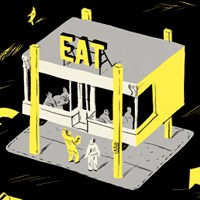Investing in a proven restaurant consultant can pay big dividends
t the recent Foodservice Interchange Conference in Toronto, the belle of breakfast, Cora Tsouflidou, easily commands the attention of the 200-plus people in the room. Up at the dais, she’s delivering delightfully candid details about how she managed to build her business into one of the great success stories of the past 20 years. An artful storyteller, Tsouflidou fondly recalls one morning where she was manning the griddle at her first store — freshly divorced and trying to make enough money to feed her three kids — when a man in an expensive three-piece suit asked her, “Where exactly do you think you can go with this kind of concept?”
Back then, though she was only running a tiny, 29-seat snack bar, she was already thinking big. “Do you know how when people think of hamburgers they think of McDonald’s?” Tsouflidou told him. “I want to be known for breakfast.”
Twenty-two years later, with 114 Cora’s breakfast and lunch locations scattered across eight Canadian provinces, she’s well on her way, but Tsouflidou didn’t do it all on her own. Her children were integral to the process and so was one particularly important contributor — that same man in the three-piece suit. Not only did he become a loyal customer, he was a shrewd business consultant as well. He worked with Tsouflidou and her children to define a mission statement and lay the critical groundwork for growing her business into an incredibly successful chain.
“I couldn’t believe how much money he charged us at the time,” says Tsouflidou, “but I can tell you now it was worth it.”
That’s the kind of testimonial foodservice consultants enjoy hearing. They also want you to know that turning to them for help doesn’t have to happen only when you’re preparing to open a new concept, or, gasp!, when your existing one is floundering. Consultants are more than cleaners called upon to mop up particularly messy situations — like Harvey Keitel’s character “The Wolf” in the movie Pulp Fiction — in fact, some of the mostsuccessful restaurateurs in Canada meet with consultants regularly.
“We work with clients who are in start-up positions and clients who have distressed properties that need help,” says Geoff Wilson, president of FS Strategy in Mississauga, Ont. “Having said that, more of our work is with clients who have ongoing, sustained business they want to enhance.” FS Strategy consults and plans for clients in all sectors of the foodservice industry, including growers and processors, distributors, operators and landlords. Wilson says the majority of his work focuses on helping organizations improve performance, capitalize on new opportunities, explore new markets and innovate.
People hire consultants for a few reasons, he says. “First, they don’t have the in-house resources to pull it off and don’t want to have that in-house resource on an ongoing basis. Second, they need an independent opinion, because people inside an organization are sometimes not in a position to be objective. And third, they don’t have a particular expertise, capability or market understanding.”
And in a nickel-and-dime business, where margins are shrinking each day, every penny must be accounted for, says Wilson. “In this industry, it always comes back to basics. If you don’t have the basics in place, you’re going to struggle to make money.”
Those basics include making sure employees are properly deployed to meet demand, not to mention ensuring they understand what they’re doing when they’re there. Mike Walmsley of Cobalt Hospitality Consulting in Vancouver says knowing how to keep your employees happy and your HR function running smoothly are keys to a successful eatery.
For example, some clients he’s worked with were losing as much as 25 per cent of their beverage product through improper processes and procedures, says Walmsley, a long-time veteran of the hotel F&B business. “In one specific case, they were pouring close to $80,000 dollars of draft beer down the drain every year.”
Cobalt clients can have a sort of diagnostic run on their business to see where the leaks are in the areas of food, beverage and labour control. What are some of the other pitfalls for struggling restaurants? “Poor service and missed opportunities for sales,” says Walmsley. “It sounds simple, but some people still don’t get it.”
When Jerry Webb opened his restaurant in 1946, it was decades before he’d even learn that restaurant consultants existed. But because his eatery, Mother Webb’s Steakhouse, was located just off the Trans Canada Highway in Antigonish, N.S., and he was incredibly hardworking and passionate about the industry, he still managed to build a fairly sound business. “The industry has changed 100 per cent, five or six times over,” he promises, running through the shady past practices of meat storage and food handling, “and I can assure you there were no consultants back then.”
In the 1970s, however, Webb visited a restaurant tradeshow in Toronto and became acquainted with some franchisors with whom he would eventually purchase a business. “They told me, ‘If you want to own this franchise, you better do what you’re told.’ I only had a Grade 8 education; I figured I wasn’t the sharpest knife in the drawer, so I did what I was told,” he says matter-of-factly. “But these guys were always willing to help. They believed in good neighbour practices. That was the first time I worked with a consultant, I guess.”
Webb continued to attend tradeshows after that, and gleaned much knowledge from the various speakers and symposiums on hand. But the depth of what he learned and applied to his business was rudimentary compared to his most recent experience working with a restaurant consultant. With 30 years as an executive chef and an F&B cost-controller, Wayne McKay implemented his own web-based application, called Menu Tools, which accurately measured the true cost of each expenditure made at Mother Webb’s and adjusted it accordingly.
He came in for a day and watched Webb’s entire operation run, making notes on what he saw. Some portions were too large, the mushrooms weren’t dried properly, the plates were too cold — Webb listened to everything. McKay also looked at an item that was selling for $8, and told him he should be selling it for $11, recalls Webb, who didn’t think he could because his customers would get too upset about it. “But Wayne told me, ‘People have to pay for your food. You’re better off dropping it from your menu if you don’t do this mark-up. Put the price up and see what happens.’”
Though he was still reluctant, Webb raised the price and didn’t lose any sales. “Wayne has information from the thousand or so restaurant clients he’s worked with in the past, so I trusted him, and I’m glad I did.”
According to the New Brunswick-based McKay, the number 1 thing that damages a restaurant is fear of increasing prices. “Many restaurants wait months and sometimes more than a year to change their prices,” he says. What’s the second biggest problem with independent restaurateurs? More than 60 per cent of them sell food without knowing the true costs and profit margins of their menu items. “They just print the menu without doing the crucial activity of costing each menu item to the penny — with the safety margins and losses built in — at the appropriate price that their target market place will see as value.”
Across Canada, foodservice consultants are applying the same methodologies for restaurateurs who, for lack of knowledge, experience or time, are having problems turning a profit. Many are experts in specific areas of the industry, like franchising, independent restaurants, in operations and food and beverage. By assessing the stability of a business and analyzing its food, liquor and labour cost controls, they’re drawing up effective game plans that can tilt the P&L ledger back to the left. But a restaurateur has to invest in the process to get there.
“It should always be looked at on a ROI basis,” says FS Strategy’s Wilson. “A company might consider having us do a large project, but that investment should come back to them in significantly higher dollars.”
In his first year, Webb says his steakhouse earned an extra $100,000 in profit, “so we never really had to ‘pay’ for the consultant. We always had money in the till.”
Editor’s note: Looking for a consultant? Don’t forget to check out our online Buyer’s Guide.
Illustration by Paul Blow





















